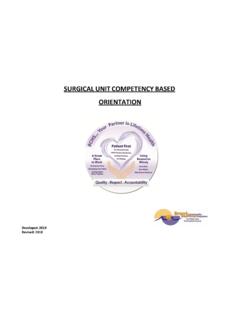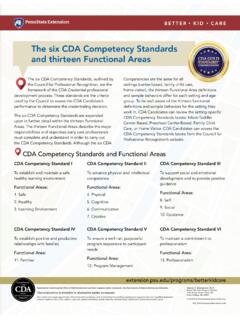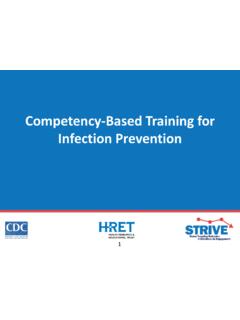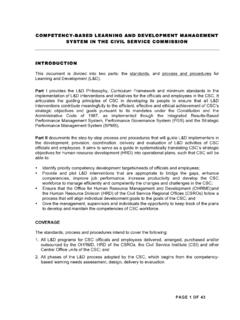Transcription of Personal Care Attendant Competency Development Guide
1 Personal CARE Attendant Competency Development GUIDEP ersonal Care Attendant Competency Development Guide2 Introduction and OverviewA highly competent Personal care Attendant workforce is critical to the well-being and safety of individuals who need support while living in residential care and community- based settings. Personal care attendants include frontline workers who help older adults or people with disabilities in a variety of settings. Personal care attendants require a significant amount of focused training, retraining, mentoring and coaching to gain the skills needed to care for an aging population with complicated health and social care needs. The LeadingAge Workforce Cabinet has been working since April 2012 to develop tools that providers of long-term services and supports (LTSS) can use to develop and strengthen the aging services workforce across the full continuum of staff and settings.
2 During this multi-year effort, the cabinet identified a set of skills, knowledge and behaviors that it believes will help Personal care attendants deliver effective supports and services across a variety of positions and LTSS settings, including: Continuing care retirement communities. Nursing homes. Assisted living communities. Home health agencies. Home and community- based services settings. Affordable senior housing communities. Structure of this GuideThe Personal Care Attendant Competency Development Guide is based on a Personal Care Attendant Competency Model featuring four broad Competency areas:1. Technical Applied Interpersonal Self-Directed Care. Personal Care Attendant Competency Development Guide3 Personal Care Attendant Competency ModelSelf-Directed CareCultural CompetencyIndividual Rights and Choices Individualizing CareSelf-CareInterpersonal SkillsIndividual EmpowermentInformed Action based on Scope of PracticeRelationship SkillsTeamworkAccountabilityAdvocacyComm unicationEducation, Training and Self-DevelopmentEmpathyApplied UnderstandingAbuseCommunity and Service NetworkingDementiaGrief and End-of-Life CareProfessionalism and EthicsResults OrientationAging.
3 Chronic Disease and Physical DisabilitiesTechnical Skills CompetenciesADLs and IADLsEvaluation and ObservationInfection ControlNutrition and Meal PreparationProviding Services and Supports Role of Direct Care WorkerSafety and EmergencyPersonal Care Attendant Competency Development Guide4 For each broad Competency area, the Personal Care Attendant Competency Development Guide presents: Domains designed to ground each Competency in observable behaviors. Knowledge areas and key behaviors that demonstrate Competency within each domain. A checklist of specific tasks associated with performing the job pyramid-shaped graphic on page 3 depicts how Personal care Attendant competencies become more specialized, and how Personal care attendants require higher level skills, over time. The base of the model (in blue) includes the foundational attributes for technical competence.
4 The next domain (in dark green) includes the application of technical skills to the care setting. The highest domains (in light green and light blue) require interpersonal skills and competencies related to the delivery of self-directed care. How to Use This GuideThe Personal Care Attendant Competency Development Guide can be used to support workforce Development efforts and prepare workers to deliver high-quality services and supports. Frontline supervisors can use this Guide in a variety of ways, including: Continuing education: Providers can review the competencies to identify skills that are critical to the organization and that may need further Development among specific Personal care attendants or across the Personal care Attendant workforce as a whole. Continuing education can be tailored to address those learning needs.
5 Performance evaluations: The competencies can be used as a foundation for a Personal care Attendant s performance review. Existing documents used in the performance review process can be updated to make them more Competency - based . On-the-job training: Personal care attendants develop many of their skills on the job, through experiences that are organized and monitored by a supervisor. The Competency model can serve as a resource for frontline supervisors who want to craft learning activities that build the skills of Personal care attendants. The behavioral descriptors contained in the Guide can be used to instruct workers about desirable and undesirable behaviors related to a specific task. Coaching/counseling: Frontline supervisors can use the competencies in this Guide to identify any gaps in the skill sets of individual Personal care attendants.
6 Supervisors can teach and motivate Personal care attendants to improve their performance in these areas. The Guide can also help supervisors identify and capitalize on teachable opportunities for staff. Caveats and Clarifications Please keep the following caveats and clarifications in mind when reviewing and using the Personal Care Attendant Competency Development Guide . Providers need to be realistic. It is not realistic to expect the Personal care Attendant to possess every skill listed within the Competency model. Working together, providers and Personal care attendants can use this tool to identify and build up skills that are not currently present in the organization, either for a particular Personal care Attendant or across the organization s Personal care Attendant workforce. Individuals receive services and supports.
7 The LeadingAge Workforce Cabinet understands that providers deliver long-term services and supports to a variety of individuals in a variety of settings. Personal Care Attendant Competency Development Guide5 Some providers refer to these individuals as residents, while other providers call them clients. Still others use additional terms to describe the people who receive services and supports. For clarity s sake, this Guide refers to all recipients of long-term services and supports as individuals. Family members and others support the individual. The LeadingAge Workforce Cabinet also recognizes that many individuals have a support network consisting of family members, friends, neighbors and/or other members of the community. This support network is an essential element of the long-term services and supports system and must be involved in designing, implementing and assessing an individual s service plan.
8 For clarity s sake, this Guide refers collectively to members of the individual s support network as the family/support network. Personal Care Attendant Competency Development Guide6 Technical Skills Core CompetenciesDomainBehaviors that Demonstrate CompetencyAssistance with Activities of Daily Living and Instrumental Activities of Daily Living Supports activities of daily living (ADL) and instrumental activities of daily living (IADL) for individuals1 as a way to maximize their independence and well-being. Incorporates an understanding of the aging process and individual preferences into ADL and IADL and Observation Understands formal and informal assessment practices in order to respond to the needs, desires and interests of individuals. Knows the individual s baseline and communicates changes to a supervisor or other appropriate Control Applies principles of infection control in all activities, and uses standard precautions as indicated.
9 Demonstrates consistent and appropriate hand-washing techniques, including use of hand-sanitizing and Meal Preparation Facilitates healthy nutrition by assisting the individual with meal planning, food preparation and serving, and food shopping and handling, in accordance with the individual s preferences and plans. Ensures the individual is well nourished. Understands and promotes the importance of good nutrition and Services and Supports Implements and coordinates the plan of care to provide emotional and physical support to the individual. Conducts outreach and engagement to address the individual s basic of Direct Care Worker Understands the role of the direct care worker in relation to other team members and individuals receiving services in various long-term services and supports settings.
10 Understands how a Personal care Attendant s approach can affect an individual s behavior. Exhibits appropriate responses to the family/support networks. Understands the boundaries of his/her job description and scope of and Emergency Ensures that the environment promotes Personal safety for individuals. Adheres to procedures necessary to maintain a safe environment and minimize risks. Practices actions to take in response to emergencies. Focuses on injury prevention by promptly identifying and reporting potential hazards that threaten an individual s safety. Recognizes and responds to common life-threatening injuries or illnesses by providing appropriate interventions, such as cardiopulmonary resuscitation (CPR) and first This Guide refers to all recipients of long-term services and supports as individuals.










